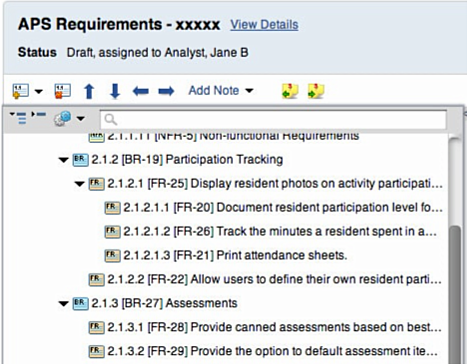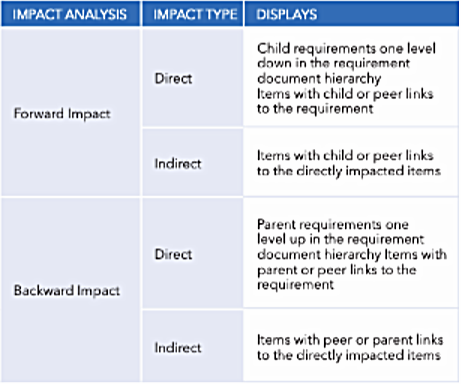Changes to your requirements have consequences. To make informed decisions with your product, leaders must consider all of the potential implications. The best way to do this is by performing a detailed impact analysis whenever a requirements change is requested.
What is an Impact Analysis?
An impact analysis is the process of identifying the potential consequences of a requirements change and estimating the necessary modifications to accomplish the change.
The impact may be minimal if the change is requested early in the development cycle, or it may be more far-reaching if requested later in development or testing. Impact analysis exposes requirement dependencies and the status of dependent items in the development cycle, which can help you make more accurate, informed decisions about change requests.
Performing an impact analysis can help development teams:
- Reduce the risk of missing changes to dependent items.
- Eliminate unexpected consequences, such as impacting another component that reuses a requirement as a result of making a change.
- Identify new requirements or other items, such as additional test cases that need to be created as a result of changes.
Types of Impact Analysis
The two primary forms of impact analysis are forward and backward impact analysis. Each type can be conducted within Perforce ALM.
Forward impact analysis determines the child requirements and other dependent items that may be affected by requirement changes. For example, a change to a high-level business requirement may affect all child functional requirements, or a change to a requirement may affect all test cases linked to it.
Backward impact analysis determines the parent requirements and other dependent items that may be affected by requirement changes. For example, a suggested change to a child requirement may conflict with its parent requirement, or a feature request may affect the requirement created to address it.
▶️ Watch Our On-Demand Video Series
Back to topPerforming an Impact Analysis
You’ll want to conduct an impact analysis when a change is proposed but before it is proposed. The most efficient way to perform an impact analysis is to do so within your lifecycle management tool.
In Perforce ALM, a change impact analysis is done by accessing the Traceability tab. Click Impact Analysis and then select the box for Forward Impact, Backward Impact, or both. Requirements that are related in a requirement document or linked to each other are displayed, as well as linked test cases, test runs, and defects.

Detailed information is displayed for each dependent item to help you determine the item’s status and view more about its relationship with the requirement. Forward and backward impact analysis both display directly and indirectly impacted items. The following table includes the items that are displayed for each type of impact analysis. The following forward impact analysis example shows the table of contents for a requirement document. Notice the relationships that FR-25 has. It is the parent requirement of requirements FR-20, FR-26, and FR-21.

In this example, the child requirements of FR-25 are displayed in the Impact Analysis area. Test cases and test runs linked to the requirement FR-25 are also displayed. If the requirement changes, these dependent items should be investigated to determine if additional changes are needed.

Back to top
Impact Analysis Reports Generated in Perforce ALM
If a change request has the potential to affect several requirements, you may want to use Perforce ALM reports or the Analyze Traceability dialog to evaluate requirement relationships on a broader scale.
Requirement Document Impact Report
The Requirement Document Impact report displays all requirements and dependent items that are included in a requirement document. This report can help you gauge how far-reaching the effects of a requirement change are and trace relationships in the context of the entire project.
The impact report displays the hierarchical outline of requirements. Test cases are displayed under related requirements, test runs are displayed under related test cases, and defects are displayed under related test runs. You can easily spot and evaluate dependent items to determine if they may be impacted by changes.
Each item’s status is displayed to help you see where all items are within their lifecycle. Requirement risk and difficulty are also displayed to help you further assess the impact of making a change. Click the item links to view more information about an item.
Requirement Forward Traceability Report
The Requirement Forward Traceability report displays a specific set of requirements and dependent items in a table format. This report can help you quickly see which requirements have downstream dependencies that may be affected by requirement changes. You can also identify gaps, such as requirements that do not have related test cases.
You can filter this report to include a set of requirements, regardless of the requirement document they are included in. The report displays requirements and any test cases or defects linked to each requirement, which gives you a quick summary of the number and type of dependencies.
Matrix Reports
Matrix reports include information to help you analyze linked and related items in a configurable table format. These reports are yet another way to expose all items that may be impacted if you make a change.
Unlike the Requirement Forward Traceability report, you can define the columns to include in the report, items displayed in columns, how columns are related, details displayed about items, and other report content.
Make Informed Decisions with Perforce ALM’s Impact Analysis
Perforce ALM’s impact analysis capabilities provide a clear picture of relationships between items so you can accurately determine the impact of changing requirements. A better understanding of these relationships will help you ensure that changes are not missed and do not negatively affect the project outcome.
To learn more about the power of performing impact analysis in Perforce ALM, download our expanded white paper on the topic or watch our Perforce ALM Video Series.
